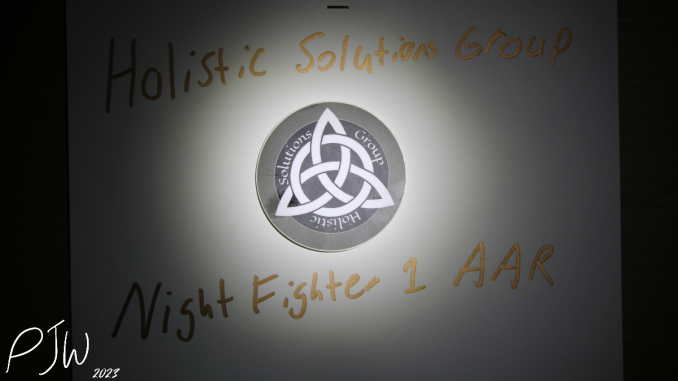
In the Fall of 2022, a friend of mine notified me about Holistic Solutions Group (HSG) coming to our part of Utah. He sent me a link, and I signed up for the Night Fighter 1 class on the spot. Two months later, the class occurred, and I very much was satisfied with it. What entails the HSG Night Fighter 1, and is the class worth your time and money?
Who is Holistic Solutions Group, and What is Night Fighter 1?
Holistic Solutions Group is a training company, based in Kansas City, Missouri. Their instructors have backgrounds in law enforcement and the military, and are trying to pass those skills onto a wider audience. For the specific class I attended, Chance and Jay from HSG instructed.
Night Fighter 1 (NF1) is the HSG intro to proper identification, shooting, and close quarter battle (CQB) under night vision devices. It’s a two day course, with a day of live fire, and a day of CQB/force on force (FOF) work. Combined time for both days amounted to about 18 hours of instruction. NF1 is not a beginner class. From both the intent of HSG, and from my experience, you should already understand how your weapons and gear work, and have a baseline of decent shooting ability.
The NF1 I took was held at The FARM, on Eagle Mountain in Utah. The FARM is a pretty awesome training environment and range, and holds many cool classes. The class was held on December 9th/10th, and ran from 3PM to about midnight both evenings.
HSG has a required minimum gear list for the course, but I wanted to talk about what I specifically brought, and how well it preformed.
Night Fighter 1 Gear Selection
The listing for the class has the minimum gear list, but I’ll discuss the individual pieces of kit that I used.
NF1 is an NVG and white light class, so I obviously brought those. I used my PVS31s with Team Wendy LTP bump. My helmet setup from the LTP review is how I ran the helmet at the class, and it worked quite well. For IR/white light, I ran the Arisaka/Malkoff combos on my 11.5″ AR. Both lights worked well during the class, and I’ve got no complaints with them. I did not bring an IR/visible laser to the class, and instead relied on passive aiming through and Aimpoint T-2 for the class.
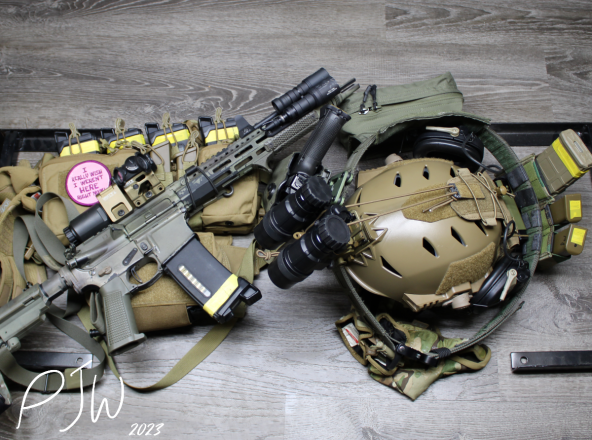
For soft gear, I wore an AWS SMU double belt, with two Esstac Kywi handgun carriers and one rifle Kywi. I also had an IFAK, and Safariland 6360 holster on the belt. While I did not use the handgun during the class, the rifle magazine carrier was very helpful for performing reloads during our live fire day. While not required, I decided to bring a chest rig to hold spare mags, markers, tools, and other useful goods. I brought one of my Haley Strategic D3CR rigs, and it worked very well.
I had no firearm malfunctions, or gear hiccups. Everything worked well, and I’m pleased with that. However, issues can occur to anyone, so I’d still recommend bringing some backup gear. I brought a Galil Ace as a spare long gun, in the case that my AR had a serious issue that could not be fixed.
Aside from the gear, I dressed for the weather, with lots of layers for my torso, boots, and warm socks. Speaking of the weather, how did that effect the class?
Weather Conditions & Class Location
HSG’s NF1 was held at the aforementioned FARM Training Center. The FARM is located about an hour south of Salt Lake City, near Eagle Mountain. The facilities onsite were great, and we used a single shooting bay for the first night, and a classroom/ shoot house for the second night.
Between the higher elevation and open expanses, the environment was quite cold. We’ve had plenty of snow in Utah, so the first night was especially frigid, with the temperature hovering between 15-20 degrees. Between the cold and the snow, we were all pretty damn cold that first evening. Everyone was bundled up, and Hot Hands were crammed in most pockets and shoes.

On night two, the temperature was a little higher, hovering around 30 degrees. The snow was also more compacted, so we were all generally feeling a little less icy on that night. The shoot house and classroom have covered roofs, so the inside of those structures were also a welcome relief. Hot Hands were still in most pockets, but the mood was generally a little happier on the warmer evening.
I mention the weather, as it was the only thing that I didn’t love over the weekend that the class was held. The frigid temps were obviously out of the control of those who taught or attended the class. However, it goes to show that packing extra layers and checking the weather are things that should be done before any outdoor class.
HSG Night Fighter 1 – Night 1
Night 1 was our live fire night. The class began around 3PM, with covering our safety and medical briefs, and beginning the courses of fire. I won’t explicitly cover every course of fire (go take the class), the first big thing that we covered was height over bore (HOB). HOB is a topic that I harp on, as people don’t practice accounting for it. HOB is the mechanical offset of your aiming device, in relation to the barrel of the firearm. At closer ranges, you’ve got to aim a little higher than you think, as the aiming device is higher on the gun than the barrel is.
The first good chunk of time was spent getting people familiar with their HOB, and using their IR/white light illuminators. Most people had their optics fairly dim, but quickly learned that they needed them brighter to be used with an illuminator under NVGs. I’ve practiced this a lot, so I know my personal settings for my Aimpoints under NVGs.
From there, we began doing drills that involved moving and shooting at the same time. At first it was very basic, forward movements, but then we transitioned to walking parallel to our targets. I’ve done a fair bit of this, especially with shooting competition, so it was enjoyable, and easy. Some of our class had to “unlearn” stopping to shoot, and hard to rewire their brains to be comfortable with shooting and moving. Hey, that’s the point of a class! During this course of fire, something interesting did happen…
Paul, and the Patagonia “5.56 Resistant Fleece”
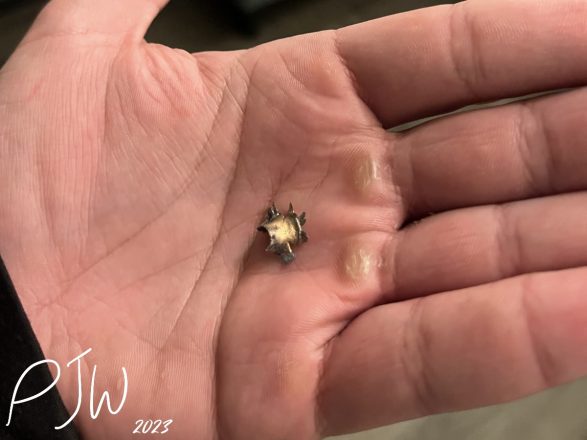
I caught some 5.56 spalling in my side during one of our movement drills. A round struck an object beyond the target, and the bullet ricocheted, with the copper jacket striking my side. Luckily, I had a mess of layers on, so I was fine. Things like this happen, which is why it is important to have eye protection on, and discuss medical prior to shooting. Shoutout to Patagonia for making a “bullet resistant” fleece. We pulled the projectile out of my side, and kept shooting.
We finished up the evening with doing some drills that simulated turning a corner, and entering a room. At this point in the night, we were all pretty tired, and extremely cold. The weather was harsh, and diminishing returns were setting in. The HSG instructors were big on not making the class entirely miserable, as the cold was wearing on us. We all had wet shoes and socks, and were generally worn out. With this, class ended around 11:15PM, and we all set out to return on the following night.
HSG Night Fighter – Night 2
Night 2 began around the same time, but most of the night was either spent in the FARM classroom, or within the shoot house. Night 2 had no live fire, and was spent practicing solo CQB, and doing FOF.
The class began with a bang, as Mike Pannone dropped by to give us a pep talk. This was super cool, as I’ve been a follower of Mike for a few years. Mike reiterated what a lot of people need to hear, which is that getting the basics and fundamentals down is what is important, as the “complex” stuff is often just doing the basics better and better. Chance of HSG and I fanboyed a little after Mike left, which was understandable.
After Mike’s pep talk, we discussed the medical brief again, and discussed the timeline for the class for the day. We were to begin with practicing movement/weapons handling with a partner, and then move onto the shoot house to practice CQB.
Again, I will not be going into detailed specifics, as this is an AAR for the class, not a synopsis to give it away. However I will go into some detail about the “Earn the shot” drill. This was a fairly straightforward, dryfire drill. Here, we were taught to turn our heads to look at a stimulus, then assess if we needed to commit our attention (and firearm) to said stimulus. It’s a basic drill, but it really beats in the idea that you’ve got to look, assess, and then react before fully committing to an action. This is vital, especially when wearing tubes over your eyes that limit your peripheral vision.
From here, we went to the shoot house.
Night 2 – The Shoot House
We began the shoot house with learning the proper way to clear and move through/past the types of corners and rooms. I learned about center fed rooms vs. corner fed, which is a simple concept, just not one that I had heard articulated that way. I hate to use buzzwords, but we did a lot of dynamic movement here. Cautious, up to the point that we had to become explosive. There was still enough light that we did this without NVGs, but then, night fell.
We returned to the classroom to scarf down some food, warm up, and discuss team tactics a little bit. This was a welcome respite before we moved to FOF.
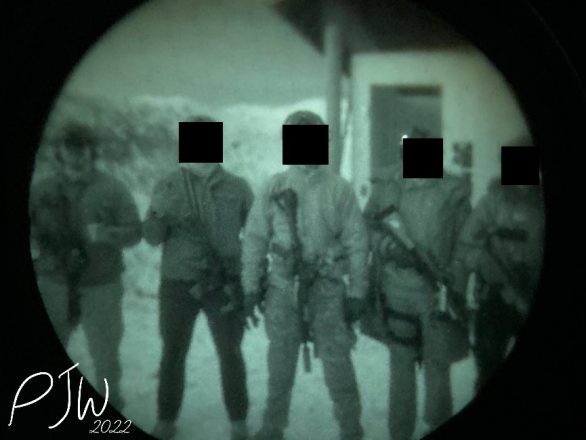
We returned to the shoot house, and began doing FOF. We used Mantis Blackbeards to “shoot” at each other as part of the FOF, and I actually brought mine along so that we’d have more to go around. It was good that I did, as one of the units that HSG had brought had a failure, and could not be used.
We did multiple scenarios, with one student playing the “good guy”, and one as the “bad guy”. Sometimes the good guy had NVGs and the bad guy did not, and sometimes both sides had tubes on. This was both very informative, and very fun. In one of my scenarios, I lit up my opponent as he jumped through a door, scoring 4 hits on him as he was in the air. This almost reminded me of laser tag, but with a lot more learning.
After we finished up the shoot house, we returned to the classroom for an AAR, and to end the class. What did I take away from the class?
HSG Night Fighter 1 – My Take Away
I am someone that owns NVGs as a sort of “novelty” piece of gear. I don’t use them in a professional sense, but I wanted to get them as I just wanted them. I’ve shot with them on prior, and have shot competition with them too. However, for me, NVGs are not something I would don in a home invasion, or a situation of that kind. However, this class is something that I am very glad to have taken.

For Night 1, I basically did not learn anything new. As someone that exclusively shoots for “improvement”, I’m already a fairly good shooter. I’ve been using the AR platform for over a decade, with optics, soft gear, and white lights. I integrated IR/NVG gear into my system in mid 2022, and as such, learned how to use that on my own time. However, the live night was very important for all of the less experienced shooters in the class. I did not find the live fire portion without merit, however, it did get me more warmed up for Night 2.
Night 2 is where I learned a lot. Clearing rooms (and why it sucks to do so) was something that I learned what to do, and what to avoid. I’ve done live fire shoot houses before, but never FOF like this. While an NVG centric class, the things I learned are applicable to white light situations too. It was enjoyable and an excellent learning experience.
My Recommendations
I can wholeheartedly recommend the Holistic Solutions Group Night Fighter 1 course. It was informative, and enjoyable. However, there are some things you should know before you go into it.
This class is oriented into familiarizing people to shoot, move, and think with their NVGs on. For most of the students, this was either their first, or one of their first times using NVGs and shooting at the same time. However, NF1 is not a beginner class. You should already know how to manipulate and shoot your weapons prior to coming to the class, it’s that the class integrates in NVG use with what you should already know.

I would strongly advise against bringing untested or malfunctioning gear to any class, let alone an NVG class. We had a few rifles that had failures, and a class is not the time that you want to find out that your gun doesn’t work. I always pack spare firearms, as it is easier to fix that blaster at home, than to try and un-f*ck it during the class. I brought tried and tested gear that I knew wouldn’t cause me any issues. You are paying to be at the class, so don’t waste anyone’s time, including your own.
Dovetailing into the prior point, you should know what the functions and features of your gear are. This sounds obvious, but knowing what the usable NVG settings on your optic are should be something you know prior to coming to the class. Knowing how to go from low to high on your IR laser or illuminator is something that you shouldn’t be finding out on the firing line. As the phrase goes, an ounce of prevention is worth a pound of cure, and saving time during a paid class is well worth it.
In Closing
Overall, I was very pleased with the Holistic Solutions Group Night Fighter 1 course. I want to thank my local friends that invited me to the class. I’d also personally like to thank Jay and Chance of HSG for coming out to instruct. They were great people to learn from, and certainly instilled confidence in the class. I’d be happy to take more classes with them whenever they are back in the area.
I’d also like to thank Mike Pannone for the pep-talk on Night 2. It was appreciated, and pretty damn cool.
The FARM is a neat training facility, with staff that are shooters, not just business people. Shoutout to Taylor, one of the owners of The FARM, for taking NF1 with us. Seeing the proprietors taking the class certainly shows how much they care about creating a great training environment.
Thanks to Dillon for being my photographer during the class.


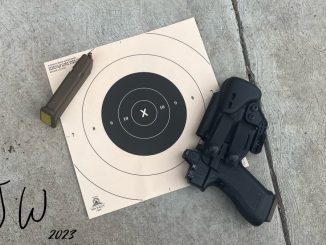

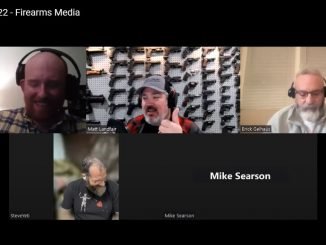
Be the first to comment